Introduction
EdTech Statistics: EdTech, short for educational technology, means using digital tools and software to improve teaching and learning. This includes things like computers, online platforms, apps, and even artificial intelligence. The goal is to make learning easier, more personalized, and accessible for students everywhere. EdTech can be simple, like digital worksheets, or advanced, like virtual reality lessons or AI tutors.
The main reasons EdTech is growing are more people using online learning, a focus on teaching that fits individual needs, and more interest in learning at any age. Governments are supporting digital education, internet access is improving worldwide, and situations like the pandemic showed why flexible learning is necessary. In countries like India, fast internet growth and content in local languages are pushing the market ahead.
In 2024, investment in edtech businesses dropped sharply. According to the Financial Times, companies offering services like online tutoring and exam practice raised only about $3 billion, a steep fall from the $17.3 billion seen at the height of the pandemic in 2021. This is the lowest level of funding since 2014, when the sector attracted just $2.3 billion, showing how far investor interest has cooled after the surge in demand during lockdowns.
Top Edtech Statistics (Editor’s Choice)
- The EdTech industry is projected to reach USD 810.3 billion by 2033, showing massive growth potential.
- Corporate EdTech already represents a USD 27.5 billion market, reflecting strong enterprise adoption.
- Around 70% of students worldwide prefer using digital tools for learning.
- K-12 EdTech usage has grown by 99% since 2020, highlighting rapid digital adoption in schools.
- Nearly 85% of teachers believe EdTech improves student engagement.
- More than 70% of colleges plan to launch new online undergraduate programs within three years.
- Education accounts for 6% of global GDP, with spending expected to hit USD 7.3 trillion by 2025.
- The world needs to upskill an additional 2 billion learners by 2050.
- 71% of online adults aged 18–29 use social media to explore educational opportunities.
- The adaptive learning segment is forecasted to reach USD 9.11 billion by 2028.
- Over 90% of U.S. college students already use online learning platforms.
- The K-12 EdTech market alone could be worth USD 253.9 billion by 2033.
- Gamification in EdTech boosts student motivation by 30%.
- Around 65% of K-12 students use some form of EdTech daily.
- EdTech firms typically generate 3,000–3,500 organic leads, but conversion rates remain low at 2-3%.
- Less than 4% of global education spending goes to technology, showing significant room for digital growth.
- India’s edtech sector has been growing at an extraordinary pace. From a market size of around $750 million in 2020, it’s projected to reach $30 billion by 2030.
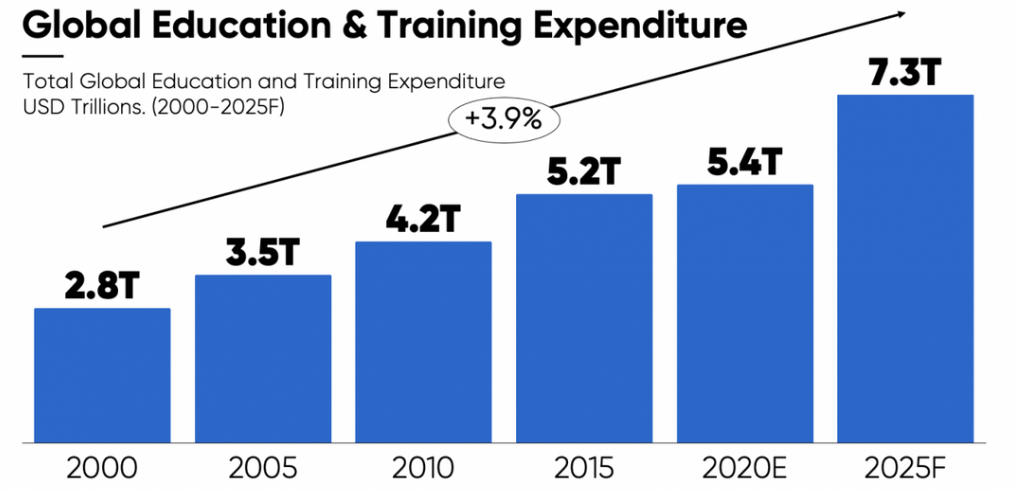
(Source – holoniq.com)
AI-Powered EdTech Statistics
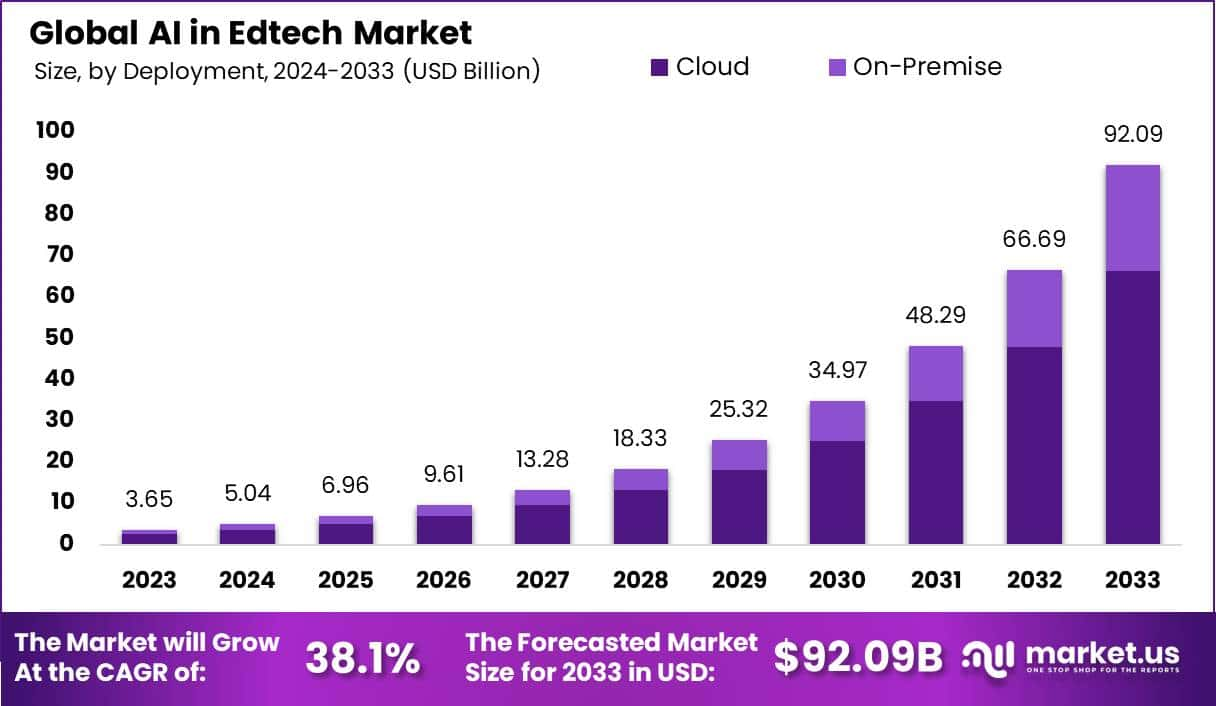
(Source – Market.us)
- 67% of institutions worldwide have adopted AI tools in teaching.
- 42% of students believe AI improves learning efficiency.
- 58% of U.S. teachers use AI platforms for personalized instruction.
- AI-driven adaptive learning has boosted student engagement by 35%.
- In 2023, the Cloud segment led AI in EdTech with 72%+ share.
- The Personalized Learning segment captured 43%+ share in 2023.
- Corporate Training Centers dominated with 45%+ share in 2023.
- North America led regionally with 37%+ share in 2023.
- Over 50% of schools and universities use AI for administration to improve quality.
- 74% of EdTech firms are investing in AI research and development.
- More than 80% of institutions plan to expand AI analytics in the next 5 years.
- 52% of higher education institutions report AI reduces administrative workload.
- 65% of students prefer AI tutors over traditional online resources.
- AI-based language learning tools grew by 150% between 2020 and 2023.
- 60% of U.S. K-12 schools use AI to detect behavioral issues.
- AI plagiarism detection has cut academic dishonesty by 25%.
- 70% of EdTech startups embed AI in their core products.
EdTech Market Size
Based on data from market.us, The global EdTech market is set for strong growth over the next decade. It is projected to reach USD 810.3 billion by 2033, rising from USD 220.5 billion in 2023, at a compound annual growth rate of 13.9% between 2024 and 2033.
Over the next decade, education will expand on a massive scale. The World Economic Forum estimates that about 800 million K-12 students and 350 million post-secondary students will graduate worldwide. By 2030, global spending on education is expected to reach around USD 10 trillion, showing how central education has become to both economic growth and social progress.
In India, the edtech sector has held steady despite tighter funding conditions. Data from PIE News shows that in the first nine months of 2024, the industry raised $278 million, a slight increase from $269 million during the same period in 2023. While growth has been modest, it highlights the sector’s resilience and continued ability to draw investor interest even in a difficult market.
Some standout companies continue to shape the industry. According to Inc42, PhysicsWallah accounted for $210 million of India’s total funding in 2024, while Byju’s secured $800 million in its latest round. In the U.S., BetterUp leads as the most valuable edtech unicorn, reflecting the global shift toward digital tools for learning, tutoring, and professional development.
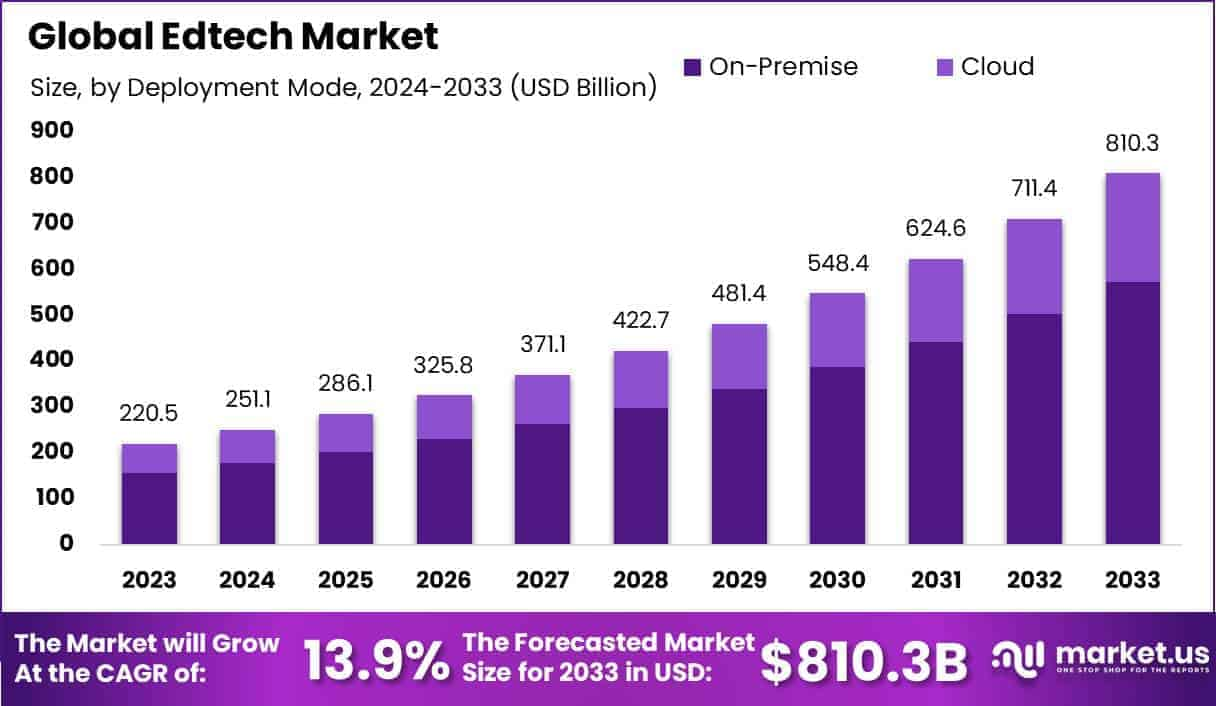
(Source – Market.us)
Key Insights Summary
- North America led in 2023 with 37.3% share, generating USD 82.24 billion in revenue.
- Middle East & Africa secured 31.0% share in 2023, driven by digital literacy and government support.
- Europe captured 29.6% share, reflecting steady EdTech adoption.
- Asia-Pacific held 24.1% share, supported by digitalization and rising education demand.
- Latin America accounted for 5.9% share, showing gradual but promising adoption.
- On-premise deployment dominated with 70.8% share in 2023.
- Hardware solutions contributed 40.7% share, highlighting strong demand for physical tools.
- The K-12 segment led education with 55.9% share, showing rapid early adoption.
- The Business segment was the top application area, accounting for 68.1% share through corporate training and upskilling.
Generative AI in EdTech Statistics
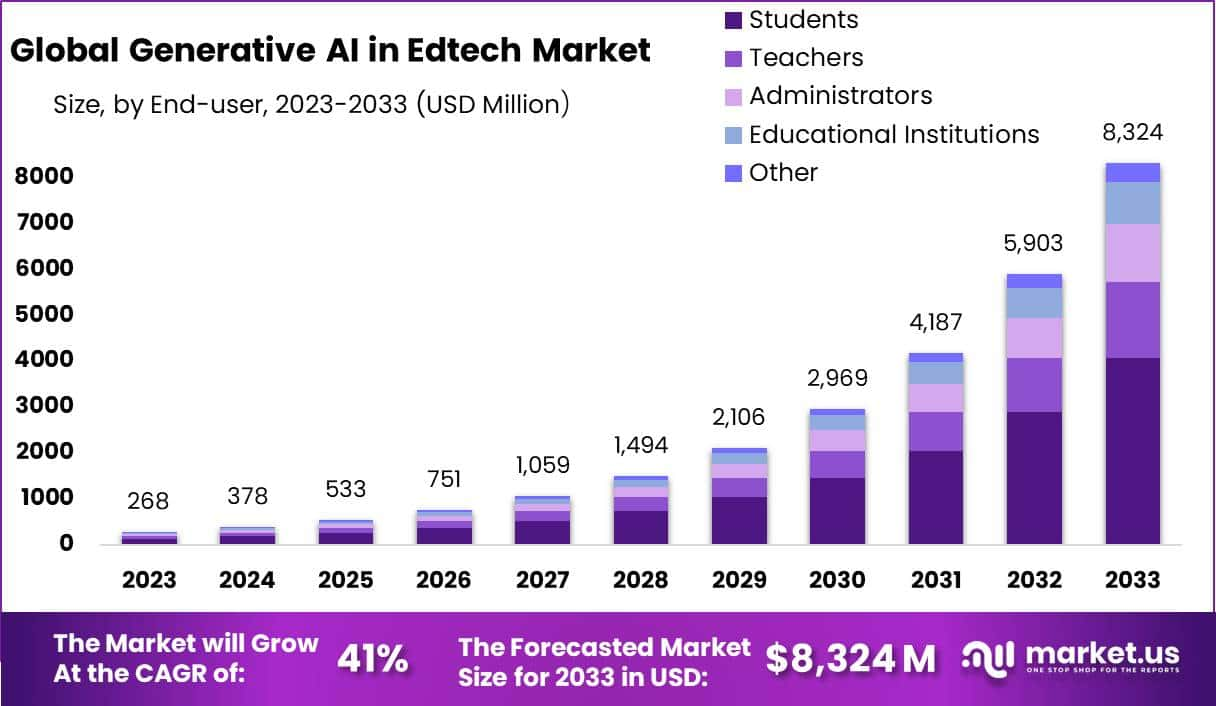
- The global Generative AI in EdTech market is projected to grow from USD 268 million (2023) to USD 8,324 million (2033) at a 41% CAGR.
- Adaptive Learning led in 2023 with 39%+ share, driven by its ability to personalize pace and content.
- Students accounted for 49%+ share in 2023, showing direct impact on learning outcomes.
- In North America, Generative AI in EdTech was valued at USD 39.1 million in 2023, with strong growth expected.
- 50% of organizations have increased investments in Generative AI.
- The broader Generative AI market is forecast to expand from USD 13.5 billion (2023) to USD 255.8 billion (2033) at 34.2% CAGR.
- Use of Generative AI for personalized learning and adaptive tutoring rose by 32% in 2023.
- Adoption for content creation and course development cut costs and time by 25% in 2023.
- Applications for language learning and translation increased by 18% in 2023, making it more engaging.
- Integration with VR/AR learning grew by 22% in 2023, offering immersive study experiences.
- Use of Generative AI for grading and assessments rose by 15% in 2023, reducing teacher workload.
- Adoption for career advice and skill-building is expected to grow by 28% by end of 2024.
- Applications in gamified learning increased by 20% in 2023, boosting motivation and engagement.
- 45% of educational institutions explored Generative AI for administrative tasks like scheduling in 2023.
K-12 EdTech Statistics
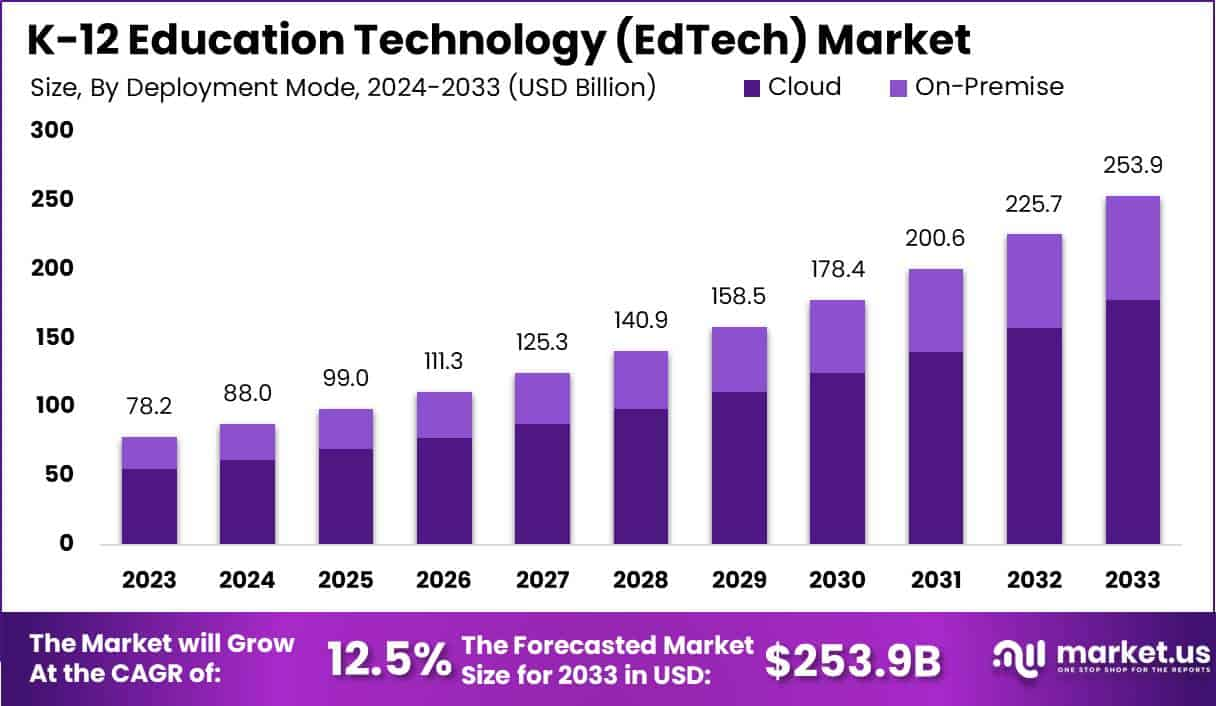
- The K-12 EdTech market is expected to rise from USD 78.2 billion (2023) to USD 253.9 billion (2033) at a 12.5% CAGR.
- The Cloud segment led in 2023, capturing 70%+ share of the market.
- Software solutions secured over 41% share, showing strong adoption.
- The K-12 segment itself dominated with more than 70% share in 2023.
- The Consumer segment held the lead with 80%+ share, reflecting wide student and parent adoption.
- North America remained the top region with 36%+ share and USD 28.1 billion in revenue in 2023.
Investment and Growth
- The EdTech industry has become a major global market, attracting strong investments and high growth forecasts.
- Global digital education spending is projected to reach USD 404 billion in 2025, up from USD 227 billion in 2020, making up nearly 5% of global education spend.
- The global EdTech and Smart Classroom market is anticipated to be USD 498.5 billion by 2032. It is estimated to record a steady CAGR of 15% in the review period 2023 to 2032. It is likely to total USD 146.8 billion in 2023.
- The industry has seen 22,000+ investment rounds, with an average deal size of USD 14.1 million and USD 10+ billion invested by leading funds.
- In early 2025, EdTech saw larger venture deals, showing investor confidence despite fewer total rounds.
- India’s EdTech sector is valued at USD 7.5 billion in 2025, projected to grow to USD 29 billion by 2030.
- By 2035, the market could expand to USD 61.25 billion, at a 15.3% CAGR.
- Funding peaked during the pandemic, faced corrections later, but continues to attract significant investor interest.
EdTech Funding Statistics

(Source – holoniq.com)
The EdTech venture capital landscape worldwide has seen significant shifts in the last decade. The funding data from 2010 through Q1 2025 shows both sharp growth and recent corrections as investors adapt to changing market realities and new opportunities. The top five regions by total investment highlight where innovation and scale are most pronounced.
- China raised $29.7 billion in EdTech VC funding, surpassing all other regions.
- The US closely follows with $28.2 billion invested in EdTech since 2010.
- India reached $11.5 billion in total EdTech venture capital, far ahead of most emerging markets.
- European ventures attracted $9.0 billion in the same period.
- The rest of the world (RoW) collectively raised $7.2 billion.
Looking at annual trends, funding ramped up dramatically in 2020, peaking at $20.8 billion. This was driven by global demand for remote learning and new digital solutions. In 2021, EdTech VC funding slowed to $16.1 billion, still a strong figure but marking the start of a cooldown.
- After 2021, the sector saw sharp declines. In 2022, funding dropped 49% to $10.6 billion.
- By 2023, there was another major fall to $3.0 billion, followed by $2.4 billion in 2024.
- For Q1 2025, only $410 million was invested, indicating ongoing caution among venture capitalists.
US Edtech Market Statistics
- The U.S. EdTech and digital literacy market is projected to grow steadily over the next decade, starting from $35.41 billion in 2024 and reaching $42.92 billion in 2025.
- The upward trend continues with values rising to $52.02 billion in 2026 and $63.04 billion in 2027, showing consistent investor and institutional confidence in digital learning.
- By 2028, the market is expected to cross $76.41 billion, advancing further to $92.61 billion in 2029.
- Entering the next decade, the market size is forecasted at $112.24 billion in 2030 and $136.03 billion in 2031, reflecting the shift toward technology-driven education models in schools, universities, and workplaces.
- The momentum strengthens in the following years, with the market climbing to $164.87 billion in 2032 and $199.82 billion in 2033, before ultimately reaching $242.19 billion by 2034. This growth path highlights the rising importance of digital literacy and online learning platforms as core components of the U.S. education system.
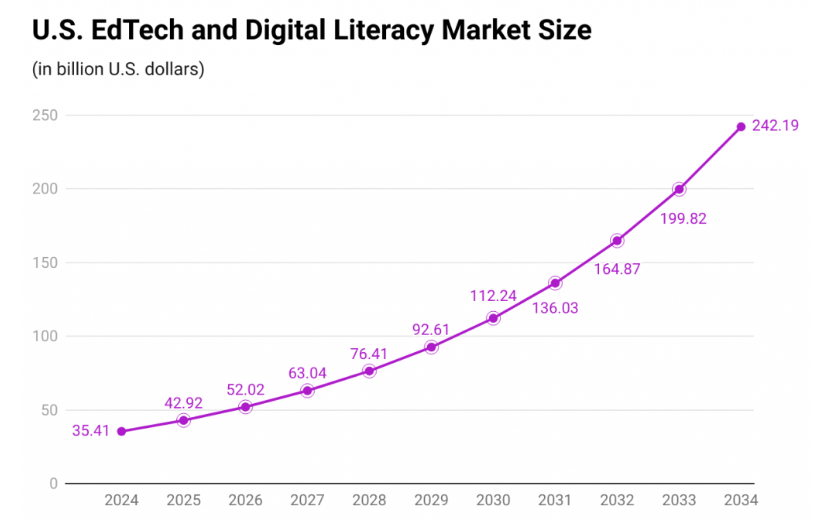
(Source – sci-tech-today.com)
Online Education/E-Learning Market Statistics
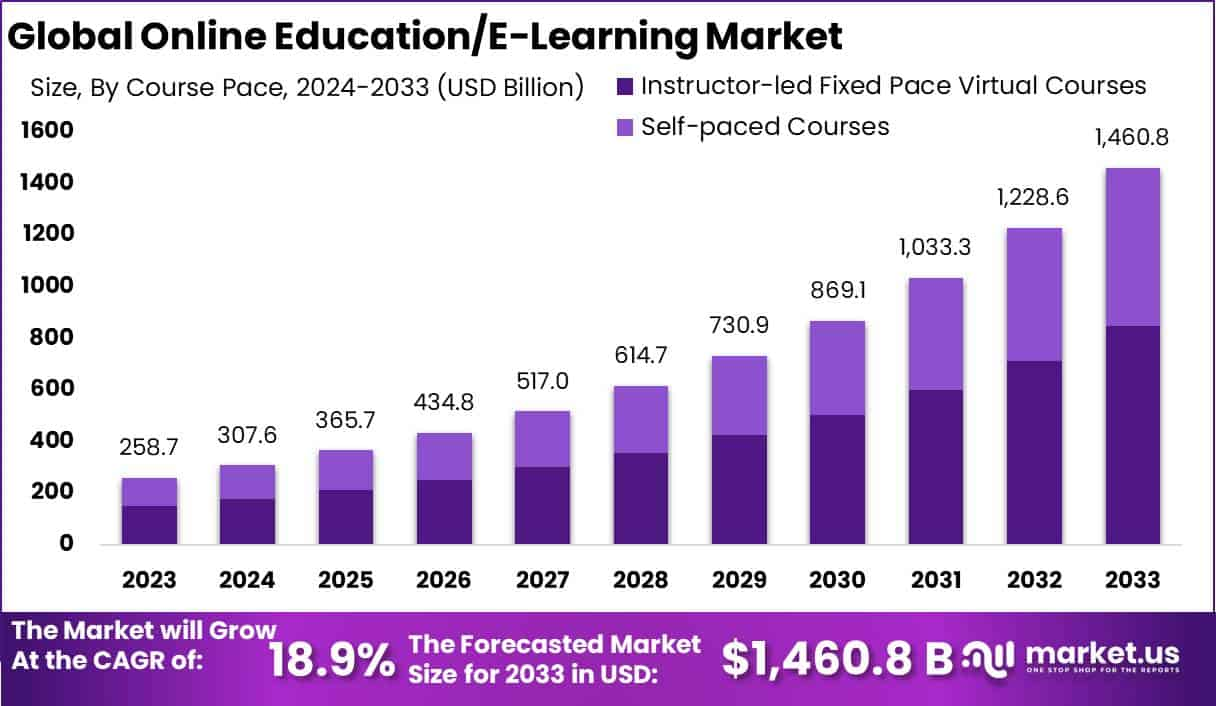
(Source – market.us)
- The Online Education/E-Learning market is projected to reach USD 1,460.8 billion by 2033, growing at a 18.9% CAGR.
- The custom e-learning segment led in 2023 with 31%+ share, highlighting strong demand for tailored solutions.
- The Primary and Secondary Education segment captured 29%+ share in 2023, showing rising adoption in schools.
- The Instructor-Led Virtual Courses segment dominated with 58%+ share in 2023, reflecting preference for structured digital learning.
- The Academic segment held 46%+ share in 2023, underlining education’s central role in the e-learning market.
User Engagement
- Around 85% of teachers believe EdTech improves student engagement.
- Gamification in EdTech boosts student motivation by 30%.
- Online learners show a 25% retention rate, compared to 58% in traditional classrooms.
- 45% of students say EdTech helps them understand complex subjects more easily.
- Nearly 80% of students prefer personalized learning powered by EdTech.
- 60% of teachers report that EdTech improves their teaching effectiveness.
K-12 Game-Based Learning Market
The global K-12 game-based learning market is poised for significant expansion, projected to rise from USD 8.46 billion in 2024 to about USD 28.21 billion by 2034, advancing at a compound annual growth rate of 12.80% between 2025 and 2034. This reflects the growing integration of interactive and immersive learning tools in classrooms, where gamification is being used to improve engagement and learning outcomes.
In 2024, North America led the market with a 38.6% share, generating nearly USD 3.26 billion in revenues. The U.S. alone contributed USD 2.93 billion, supported by strong adoption of digital learning solutions, advanced school infrastructure, and increasing demand for personalized education experiences. With a projected CAGR of 11.05%, the U.S. remains a key driver of innovation and growth in the global K-12 game-based learning landscape.
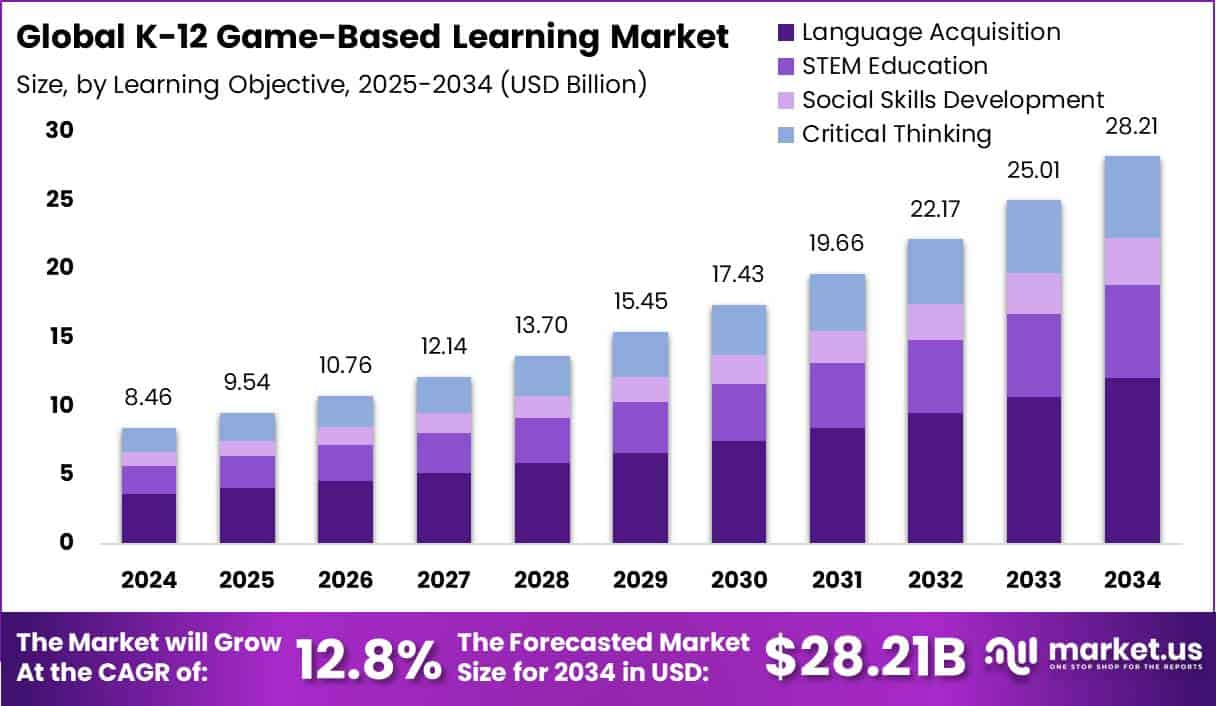
- In 2024, the Digital Games segment led the K-12 game-based learning market with 46.8%+ share.
- The Language Acquisition segment held a strong position, capturing 42.9%+ share in 2024.
- The Elementary School segment dominated end-users with 56.7%+ share in 2024.
- North America led globally with 38.6%+ share and USD 3.26 billion revenue in 2024.
- The U.S. K-12 game-based learning market was valued at USD 2.93 billion in 2024, with growth expected at a 11.05% CAGR.
Edtech Trends to Watch in 2025
In 2025, EdTech apps have become highly advanced and user-centered, offering features that make learning more effective and engaging for people of all ages. These platforms now combine smart technology with everyday needs, keeping the learner at the heart of their design.
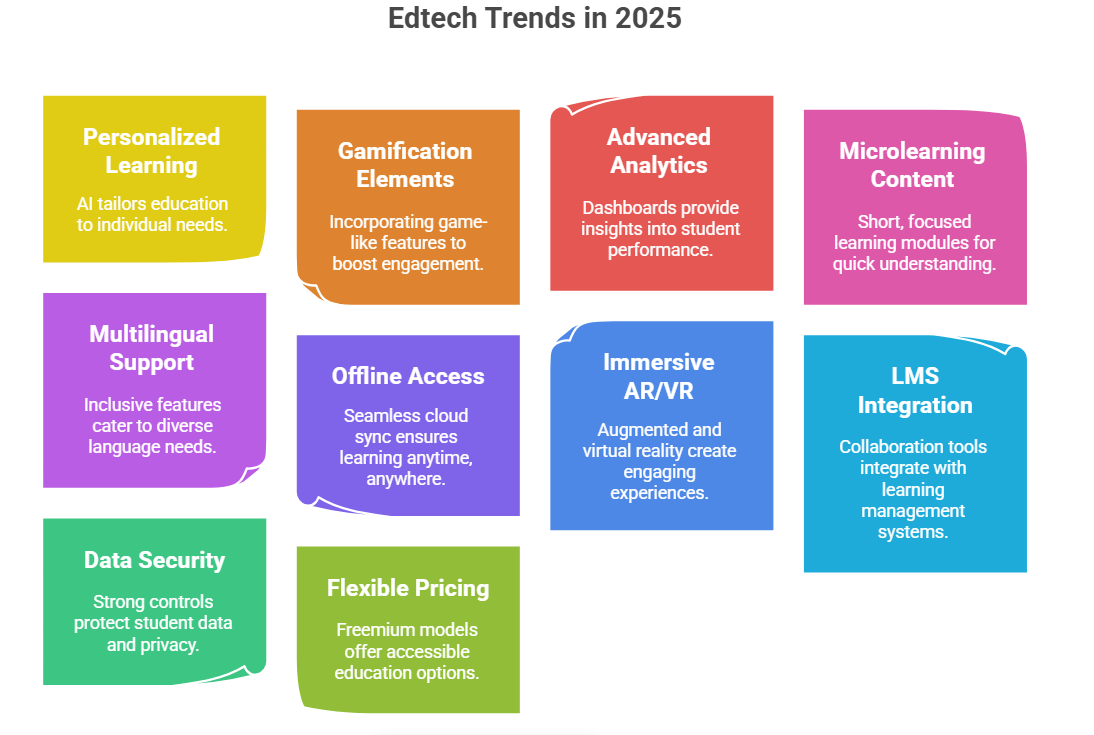
Top Edtech Companies
| Rank | Company | Headquarters | Score |
|---|---|---|---|
| 1 | Codemao | China | 99.8 |
| 2 | Youdao | China | 98.7 |
| 3 | TAL Education | China | 95.7 |
| 4 | Headway Inc | Cyprus | 95.7 |
| 5 | Xiaohe | China | 95.6 |
| 6 | Meishubao | China | 95.5 |
| 7 | Aixuexi | China | 95.2 |
| 8 | Ten Thousand Coffees | Canada | 94.4 |
| 9 | Arduino | Italy | 93.9 |
| 10 | Stepful | United States | 93.8 |
(Source – time.com)
Regional Analysis
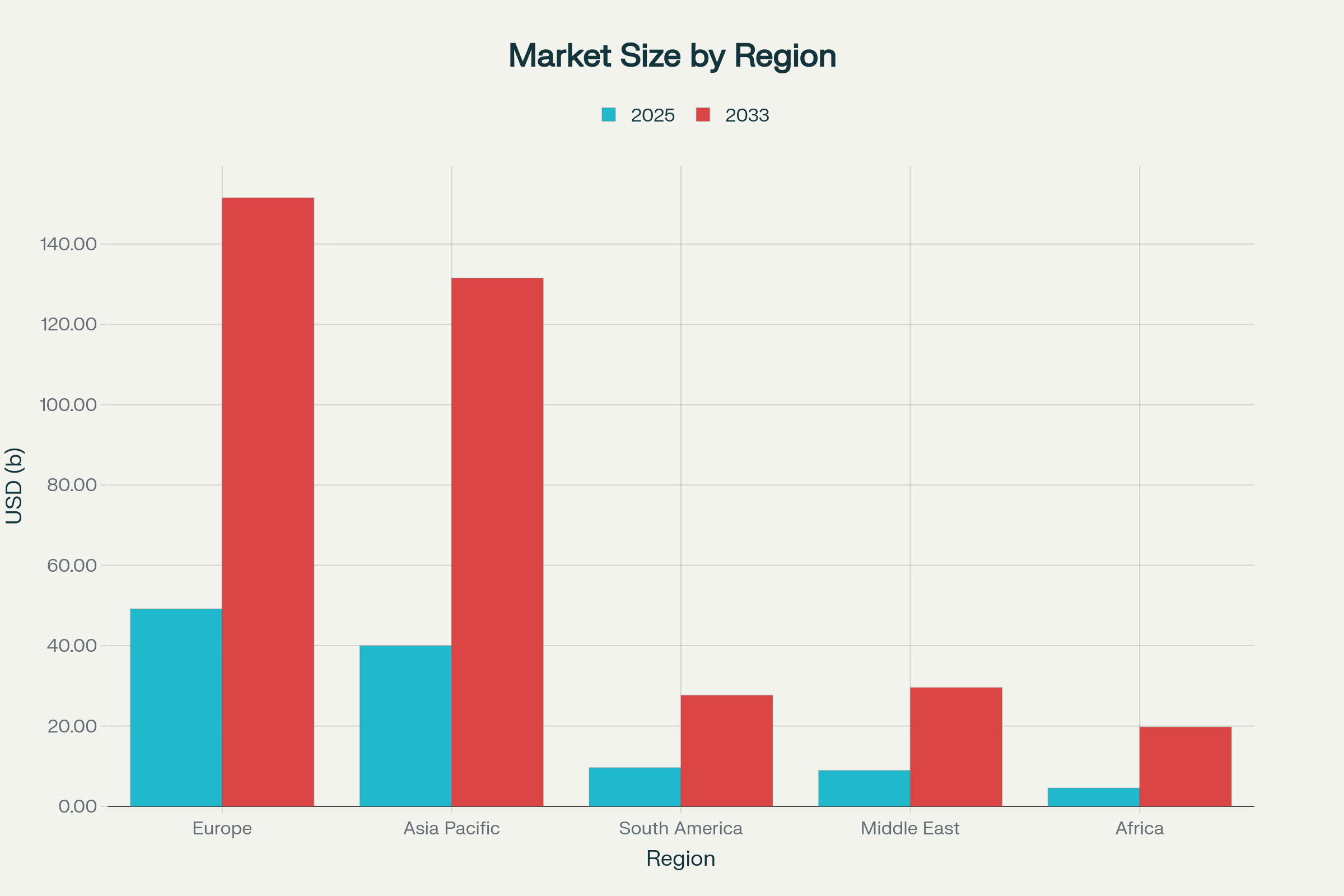
Conclusion
The education technology market is shaped by its capacity to personalize learning, foster inclusivity, and enhance operational effectiveness through digital tools. While AI, AR/VR, adaptive systems, and IoT offer compelling potential, responsible growth depends on addressing privacy, pedagogical, and access-related concerns.
Investment is shifting toward integrated AI and immersive solutions, signaling optimism for future innovation. The regulatory landscape remains evolving, and success in this domain will require close collaboration between technologists, educators, and policymakers to ensure that technology truly serves learning and human development.
Sources:
- https://gitnux.org/ai-in-the-edtech-industry-statistics/
- https://www.sci-tech-today.com/stats/edtech-statistics/
- https://time.com/collection/worlds-top-edtech-companies-2025/
- https://www.holoniq.com/edtech-in-10-charts
- https://passivesecrets.com/edtech-statistics/
- https://getstream.io/blog/edtech-statistics/
- https://askwonder.com/research/edtech-statistics-brnbmtuxk
- https://digitaldefynd.com/IQ/india-edtech-facts-statistics/
- https://explodingtopics.com/blog/edtech-stats
- https://wifitalents.com/edtech-industry-statistics/
- https://gitnux.org/edtech-industry-statistics/
- https://freedomaware.com/edtech-statistics/
- https://www.ft.com/content/54e8d249-8b95-44df-8bb4-c48ea20c7857
- https://scoop.market.us/edtech-statistics/
